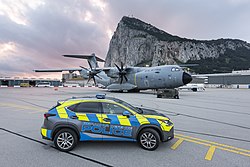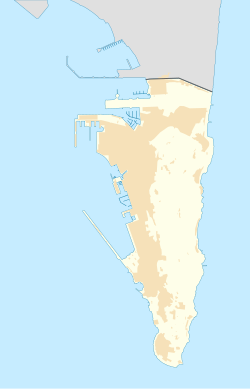| RAF Gibraltar | |||||||
|---|---|---|---|---|---|---|---|
| Gibraltar | |||||||
 | |||||||
 Guard the Gateway | |||||||
| Site information | |||||||
| Type | Permanent Joint Operating Base | ||||||
| Owner | Ministry of Defence | ||||||
| Operator | Royal Air Force | ||||||
| Controlled by | British Forces Gibraltar | ||||||
| Condition | Operational | ||||||
| Website | Official website | ||||||
| Location | |||||||
| Coordinates | 36°08′58″N005°20′50″W / 36.14944°N 5.34722°W | ||||||
| Site history | |||||||
| Built | 1942 | ||||||
| In use | 1942–present | ||||||
| Garrison information | |||||||
| Current commander | | ||||||
| Airfield information | |||||||
| Identifiers | IATA: GIB, ICAO: LXGB, WMO: 8495 | ||||||
| Elevation | 3.7 metres (12 ft) AMSL | ||||||
| |||||||
| Airfield shared with a civilian terminal Source: RAF Gibraltar Defence Aerodrome Manual [1] | |||||||
Royal Air Force Gibraltar or more simply RAF Gibraltar (also formerly known as North Front) is a Royal Air Force station on Gibraltar. No military aircraft are currently stationed there, but RAF and aircraft of other NATO nations will periodically arrive for transient stopovers, exercises, or other temporary duty. Administered by British Forces Gibraltar, the station is a joint civil-military facility that also functions as the Rock's civilian airport – Gibraltar Airport, with the civilian airport's passenger terminal building and apron facilities located on the north side of the runway while the apron and hangar of RAF Gibraltar are located on the south side of the runway.
Contents
- History
- Early history
- Post-war
- Units stationed
- Commanding officers
- Gibraltar squadrons
- Gallery
- Panoramic view
- See also
- References
- Further reading
- External links
A total of 16 personnel were reported assigned to RAF Gibraltar as of 2023. [2]








